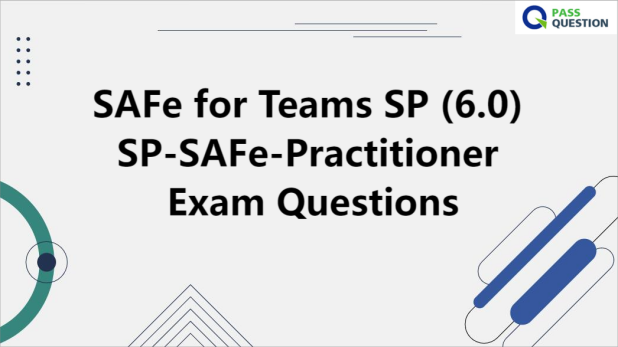SAFe for Teams SP (6.0) SP-SAFe-Practitioner Exam Questions
To successfully pass the SAFe for Teams SP (6.0) - SAFe Practitioner exam, PassQuestion provides the latest SAFe for Teams SP (6.0) SP-SAFe-Practitioner Exam Questions that are designed to test your knowledge and provide valuable insights into the types of questions that may appear on the actual exam. By using the latest SAFe for Teams SP (6.0) SP-SAFe-Practitioner Exam Questions from PassQuestion, you will have access to the most up-to-date information and be better equipped to tackle the exam with confidence. Furthermore, studying the latest exam objectives and practicing with relevant questions will not only enhance your understanding of the subject matter, but also increase your chances of passing the exam easily.

SAFe for Teams SP (6.0) - SAFe Practitioner
A SAFe Practitioner (SP) is a Scaled Agile Framework (SAFe) team member responsible for using Scrum, Kanban, and Extreme Programming (XP) in a SAFe environment. Key areas of responsibility include planning Program Increments and Iterations, breaking requirements into stories, developing incrementally with built-in quality, demonstrating value at a team and program level, and problem-solving impediments to drive relentless improvement.
SP-SAFe-Practitioner Exam Details
Duration: 90 minutes
Number of Questions: 45
Passing Score: 80%
Delivery: Web-based, closed book, no outside assistance
Cost: First attempt included in the course registration fee if taken within 30 days of course completion
Retake Fee: $50; $250 for SPC
Retake Policy: First retake - May be taken immediately after the first failed attempt.
Second retake - May be taken 10 days after the first retake.
Third retake - May be taken 30 days after the second retake.
All subsequent retakes require a 30-day wait.
SP-SAFe-Practitioner Exam Topics
Introducing SAFe (6-12%)
- Business agility
- Lean-Agile mindset
- Core Competencies - APD and TTA
- SAFe Core Values and Principles
Forming Agile Teams as Trains (15-21%)
- Agile team characteristics
- Agile team roles
- Scrum and Kanban
- ART characteristics
- ART roles
Connect to the Customer (9-14%)
- Customer-centric mindset
- Product vision and roadmap
- Story and Feature components
Plan the Work (21-25%)
- Writing and estimation
- Team Backlog
- Team Planning
- PI Planning
Deliver Value (13-18%)
- Continuous Delivery Pipeline
- Sync events
- Built-in quality
Get Feedback (6-12%)
- Feedback techniques
- Team and System demo
Improve Relentlessly (13-18%)
- Competency
- Flow
- Outcomes
View Online SAFe for Teams SP (6.0) - SAFe Practitioner SP-SAFe-Practitioner Free Questions
1. What are the SAFe Core Values?
A.Code Quality, Fast Feedback, Alignment, Trust
B.People and Culture, Transparency, Collaboration, Responding to Change
C.Commitment, Competency, Collocation, Culture
D.Built-in Quality, Program Execution, Alignment, Transparency
Answer: D
2. What are two reasons Agile development is more beneficial than waterfall development? (Choose two.)
AIt requires phase-gate approvals to ensure that everyone is moving together
BIt increases productivity and employee engagement
CIt allows businesses to deliver value to the market more quickly
DIt relies on external provider dependencies
EIt allows management to track project progress based on steering committees and metrics
Answer: B, C
3. What is the purpose of the Iteration review?
A.To serve as a forecasting meeting where the work is estimated for the Program Increments
B.To show the backlog items and work on possible Solutions for the backlog items
C.To measure the team's progress by showing working Stories to the stakeholders and getting ^ feedback from them
D.To identify where there is too much work in the system and where the teams are being ^ overloaded
Answer: C
4. Which two statements describe the responsibilities of the Product Owner? (Choose two.)
A.To be a single voice for the Customer and stakeholders
B.To own and manage the Team Backlog
C.To ensure the team follows Agile principles and practices
D.To protect the team from external forces
E.To coach the team
Answer: A, B
5. What is one of the typical Kanban classes of service for Agile teams?
A.Review
B.Fixed-date
C.Funnel
D.Accepted
Answer: B
6. What is the goal of the SAFe House of Lean model?
A.Innovation
B.Relentless Improvement
C.Flow
D.Value
Answer: D
- TOP 50 Exam Questions
-
Exam
All copyrights reserved 2025 PassQuestion NETWORK CO.,LIMITED. All Rights Reserved.

